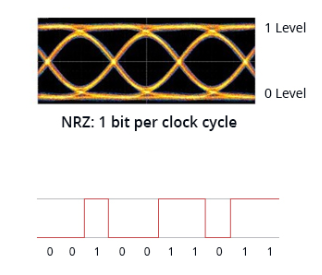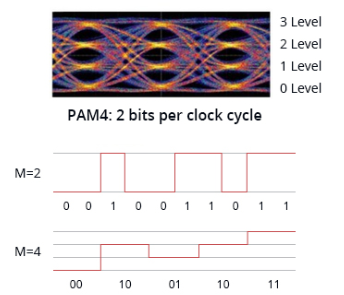
PAM4 (Pulsamplitudenmodulation 4) dient zur Umwandlung digitaler Daten in analoge Signale. Im 400G-Ethernet wird PAM4 zur Umwandlung digitaler Daten in optische Signale für die Übertragung über Glasfasern eingesetzt. Die PAM4-Technologie stellt vier verschiedene digitale Zustände dar, indem sie Amplitude und Phase des optischen Signals ändert, wobei jeder Zustand zwei Datenbits repräsentiert. Im Vergleich zur herkömmlichen NRZ-Modulationstechnologie (Non-Return-to-Zero) kann PAM4 bei gleicher Bandbreite mehr Daten übertragen und so die Datenübertragungsrate erhöhen. Im 400G-Ethernet wird die PAM4-Technologie häufig für die Datenübertragung zwischen optischen Modulen und Glasfasern eingesetzt.
AM4-Vorteile:
1. Verbessern Sie die Bandbreitennutzung: PAM4 hat bei gleicher Baudrate den doppelten Durchsatz von NRZ, sodass es die Netzwerkbandbreite erhöhen kann, ohne zusätzliche Glasfasern hinzuzufügen, wodurch die Bandbreitennutzung effektiv verbessert wird.
2. Geringerer Signalverlust: PAM4 ermöglicht die Übertragung der doppelten Informationsmenge pro Symbolperiode als NRZ, sodass bei gleicher Coderate die Baudrate (Symbolrate) von PAM4 nur halb so groß ist wie die des NRZ-Signals, wodurch der Signalverlust bei der Signalübertragung reduziert wird. Dieser Vorteil ermöglicht es PAM4, vorhandene Kanäle und Verbindungen für höhere Bitraten zu nutzen, ohne die Kanalverluste zu erhöhen.
3. Reduzieren Sie den Bedarf an optischen Geräten: PAM4 verwendet ein Modulationsformat höherer Ordnung, wodurch die Anzahl der verwendeten optischen Geräte reduziert und die Leistungsanforderungen an optische Geräte gesenkt werden können, wodurch die Kosten gesenkt werden.
4. Geeignet für eingebettete DWDM-Netzwerke: Optische PAM4-Module können direkt in Switches eingebetteter DWDM-Netzwerke verwendet werden und bieten kostengünstige und einfache Lösungen für Kunden, die eingebettete DWDM-Datennetzwerke aufbauen.
Nachteile von PAM4:
1. Begrenzung der Übertragungsdistanz: Optische PAM4-Module erfordern für die Übertragung über 5 km den Einsatz von Verstärkern und es ist ein separater DWDM-Multiplexer erforderlich, der mit Dispersionskompensation und Verstärkern ausgestattet ist, was die Komplexität und die Kosten des Systems erhöht.
2. Beeinflusst durch Rauschstörungen: PAM4 ist anfällig für Rauschstörungen. Seine zusätzlichen Spannungspegelanforderungen reduzieren das Pegelintervall, was insbesondere bei Fernübertragungen und lauten Umgebungen ein höheres Signal-Rausch-Verhältnis erfordert und die Signalqualität beeinträchtigt.
3. Kleine vertikale Augendiagrammöffnung: Die vertikale Augendiagrammöffnung des PAM4-Signals ist klein, wodurch es empfindlicher gegenüber Rauschen ist und eine höhere Bitfehlerrate verursacht. PAM4 ist jedoch möglich, da die Vorwärtsfehlerkorrektur (FEC) dem System helfen kann, die erforderliche Bitfehlerrate zu erreichen.
4. Erhöhter Energieverbrauch: Um die Bitfehlerrate im PAM4-Kanal zu reduzieren, muss am Empfangsende eine Entzerrung und am Sendeende eine Vorkompensation durchgeführt werden. Dies erhöht den zusätzlichen Stromverbrauch und die Wärmeentwicklung, was wiederum den Energieverbrauch des PAM4-Transceivers erhöht.
NRZ (Non-Return-to-Zero) und PAM4 (Pulsamplitudenmodulation 4) sind zwei verschiedene Modulationstechniken zur Umwandlung digitaler Daten in analoge Signale für die Übertragung über Glasfasern. Sie unterscheiden sich in Bitrate und Signalverlust.
PAM4 nutzt vier verschiedene Signalpegel zur Signalübertragung. Jede Symbolperiode kann zwei Bits logischer Information (0, 1, 2, 3) darstellen, d. h., es gibt vier Pegel in einer Zeiteinheit. Daher ist der Durchsatz von PAM4 bei gleicher Baudrate doppelt so hoch wie der von NRZ. Anders ausgedrückt: PAM4 kann die Netzwerkbandbreite erhöhen, ohne zusätzliche Glasfasern hinzuzufügen, und so die Bandbreitenauslastung effektiv verbessern.


Bitrate: Die NRZ-Technologie stellt zwei verschiedene digitale Zustände dar, indem sie die Amplitude des optischen Signals ändert, wobei jeder Zustand ein Datenbit darstellt. Im Vergleich zur PAM4-Technologie stellt sie vier verschiedene digitale Zustände dar, indem sie die Amplitude und Phase des optischen Signals ändert, wobei jeder Zustand zwei Datenbits darstellt. Daher kann die PAM4-Technologie mehr Daten bei gleicher Bandbreite übertragen und so höhere Bitraten erreichen.
Signalverlust: Bei der NRZ-Technologie kann es während der Übertragung zu Signalverlust kommen, da die Amplitude des optischen Signals durch Rauschen und Dämpfung geschwächt werden kann. Die PAM4-Technologie stellt vier verschiedene digitale Zustände dar, indem sie die Amplitude und Phase des optischen Signals ändert. Dadurch ist sie rauschresistenter und reduziert das Risiko von Signalverlusten.